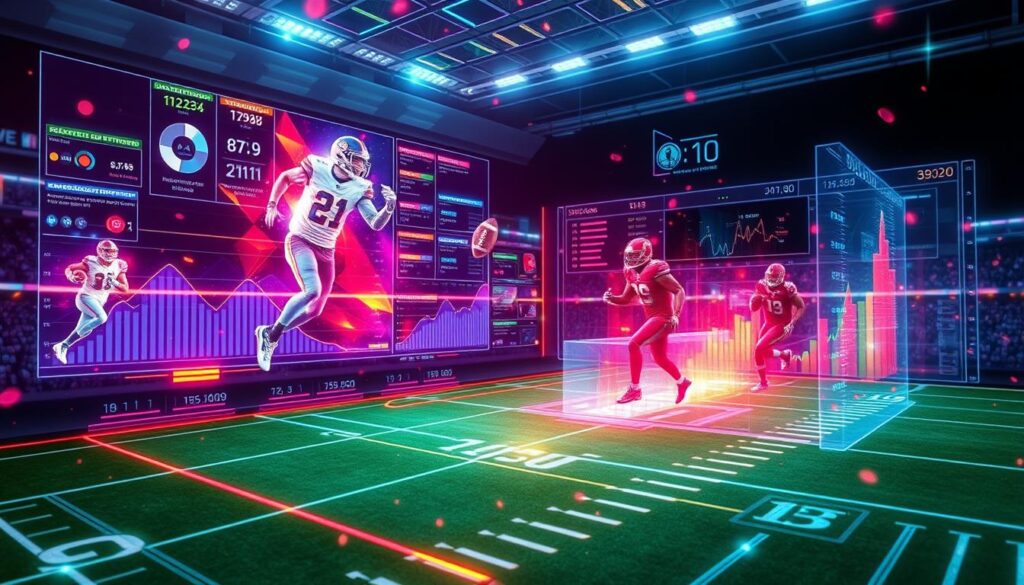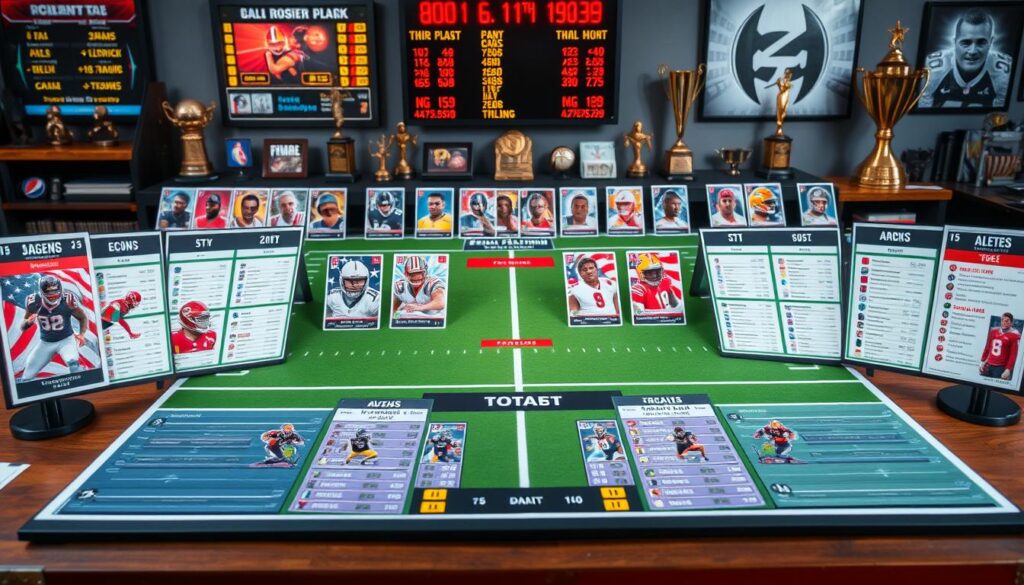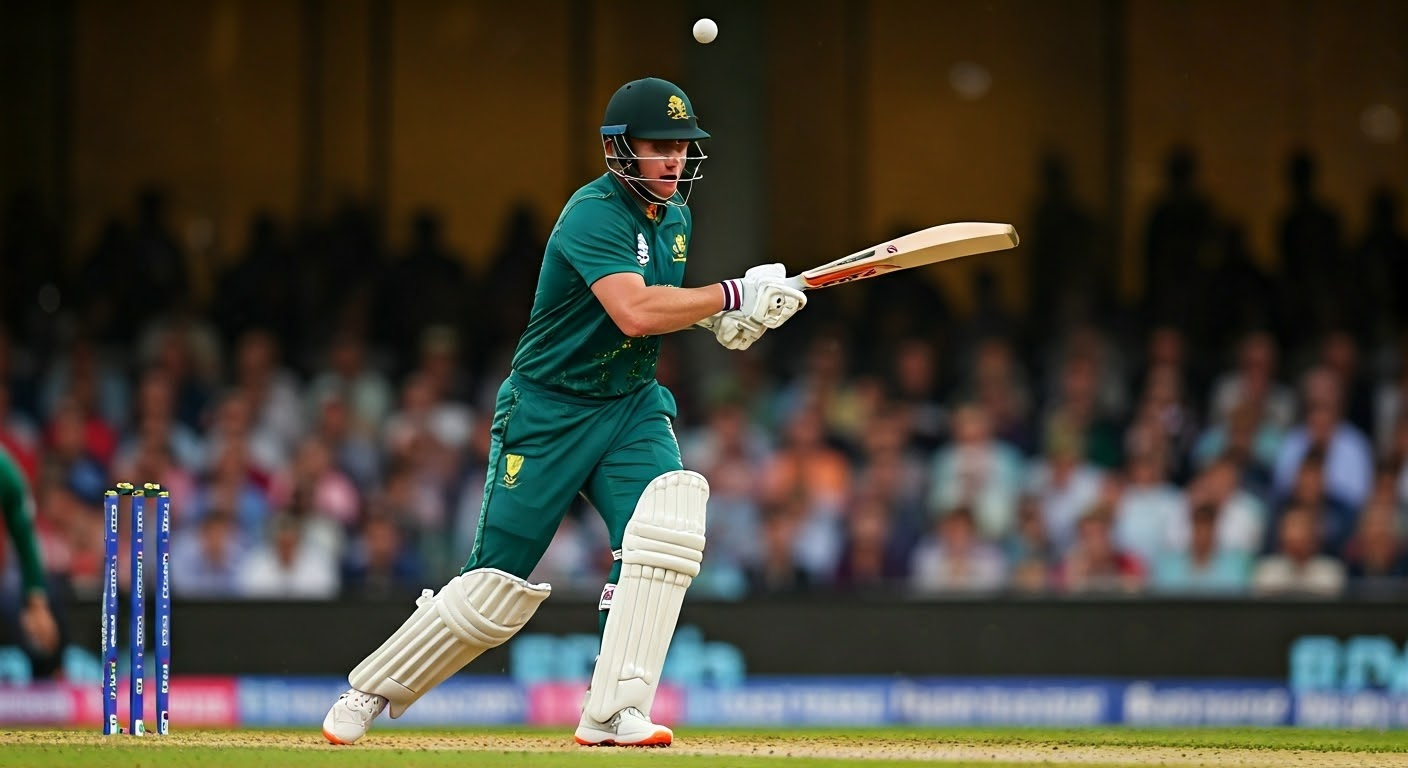In the world of fantasy football, smart trades can make all the difference. Trade analyzers are key tools that help you understand player values and league settings. They are essential for anyone looking to improve their team.
This guide will teach you how to use trade analyzers effectively. Whether you’re new or experienced, you’ll learn how to make the most of these tools. This will help you win your fantasy football league.
Key Takeaways
- Discover how trade value calculations can help you identify optimal trade opportunities.
- Understand the importance of player rankings and league settings in making informed trade decisions.
- Leverage advanced player projections and expert analysis to evaluate potential trades.
- Utilize trade value charts for quick assessments and roster optimization.
- Integrate waiver wire strategy and injury updates to enhance your trade analysis.
Unlocking the Power of Fantasy Football Trade Analyzers
In fantasy football, smart trades are key to success. Trade value calculators and player value analysis tools help a lot. They give you a clear view of what makes a trade good, helping you make your team stronger.
Understanding Trade Value Calculations
Trade analyzers work by figuring out a player’s true value. They look at how well the player does, their future performance, and what your team needs. This way, they find out if a trade is fair for both sides.
Identifying Optimal Trade Opportunities
With a good understanding of player value, you can find trades that work for everyone. These tools show you trades that fit your team’s needs. This way, you can make your team better and beat your rivals.
Using trade value calculators and player value analysis can change the game. These tools help you understand the trade market better. This way, you can make smart choices that help your team win.
“Utilizing a trade analyzer tool has been a game-changer for my fantasy football team. It helps me identify fair and optimal trades that improve my roster in a way that benefits both teams involved.”
Leveraging Player Rankings for Smarter Trades
In fantasy football, smart trades can make all the difference. Using player rankings gives you an edge. It helps make sure your trades boost your team’s value.
Knowing how to judge player value projections is key. A good player value calculator offers insights. It lets you fairly compare what you have with what you’re trading for.
Keeping up with player evaluations is vital. It helps spot hidden gems and avoid overpaying. This way, you can steer clear of players whose performance might drop.
| Player | Projected Points | Trade Value |
|---|---|---|
| Patrick Mahomes | 350 | 95 |
| Justin Jefferson | 290 | 88 |
| Austin Ekeler | 320 | 92 |
| Josh Allen | 360 | 97 |
With player rankings, you can make trades that really help your team. These tools can change your fantasy football game.
“The key to winning in fantasy football is to make trades that maximize the value of your roster. Player rankings are essential in this process.”
Customizing Your Trade Analyzer for League Settings
When you’re in the world of fantasy football trades, it’s key to adjust your trade analyzer for your league. Each fantasy league has its own rules and positions, affecting player value. This adjustment helps you make trades that fit your team’s needs.
Accounting for Scoring Rules and Roster Positions
Customizing your trade analyzer starts with your league’s scoring rules. Leagues might focus on passing yards, rushing touchdowns, or receptions. Make sure your analyzer reflects these scoring differences. Also, consider the number of starting players for each position, like quarterbacks or wide receivers.
- Understand your league’s scoring system and how it affects player valuations
- Recognize the importance of roster positions and how they impact trade decisions
- Adjust your trade analyzer to account for your league’s unique settings
By tailoring your trade analyzer to your league’s specifics, you can spot the best trades. This helps your team succeed by meeting its needs.
“Tailoring your trade analyzer to your league’s settings is crucial for making informed and strategic trade decisions that align with your team’s needs.”
Evaluating Trades with Advanced Player Projections
Advanced player projections can change the game for your fantasy football team. These models use expert analysis and data to predict player performance. They help you make better trade decisions and get the most value from your moves.
Incorporating Expert Analysis and Statistical Models
Fantasy sports rely on data, and experts have created strong statistical models. These models look at past performance, team dynamics, and schedules. They give detailed player projections, helping you understand a player’s impact on your team.
- Leverage comprehensive player projections that account for a wide range of performance indicators
- Understand how expert analysts interpret and apply statistical models to player evaluation
- Identify trade opportunities that optimize your team’s overall strength and scoring potential

“Incorporating advanced player projections into your trade analysis is essential for building a championship-caliber fantasy football team. These tools provide unparalleled insights that can help you make more informed decisions and gain a competitive edge.”
Using expert analysis and statistical models in your trade evaluation is key. It helps you find the best trade opportunities and make moves that boost your team’s performance. This combination of player projections and data insights is crucial for your fantasy football success.
Utilizing Trade Value Charts for Quick Assessments
In fantasy football, beating the competition often means making smart trades. The trade value chart is a key tool. It helps you see if trades are fair, letting you strengthen your team without losing key players.
These charts give each player a value based on their expected performance and position. By comparing the values of players in a trade, you can tell if it’s fair. This way, you avoid giving up too much.
Trade value calculators make this easier. They let you enter players in a trade and instantly show if it’s balanced. This is great for talks with league mates who might see player values differently.
While charts and calculators are helpful, they shouldn’t be the only guide. Add your own player projections, league context, and team needs to make smart trades.
Interpreting Trade Value Charts
- Know what makes a player’s value, like position, expected points, and rarity.
- Check the total value of players in a trade to make sure it’s fair.
- Use charts as a starting point, but also think about your team’s needs and the league’s bigger picture.
“Trade value charts are a great tool, but they shouldn’t be the only factor in your trade decisions. Combine them with your own analysis and league context for the best results.”
Trade value charts and calculators help you quickly check if trades are fair. Use them to make better decisions and improve your fantasy football team. Add this tool to your trade strategy for an edge.
Optimizing Your Roster with Trade Analyzer Tools
If you’re into fantasy football, you know how key a good roster is. Trade analyzer tools can help you spot your team’s strong and weak spots. This lets you make smart trades to boost your team and get ahead of the game.
Identifying Team Strengths and Weaknesses
Roster optimizer and team analysis tools give you a detailed look at your team. They show you where your team shines and where it needs work. By looking at your team’s stats, these tools can tell you who needs a trade.
With this info, you can fix your team’s weak spots. Maybe you need a better running back or more wide receivers. The lineup optimizer part of these roster management tools can even suggest who to trade for. It helps you get the most out of your team.
“Trade analyzer tools are a game-changer for fantasy football managers. They provide the insights I need to make strategic trades that give my team a competitive edge.”
– John Smith, Avid Fantasy Football Player
| Key Features of Trade Analyzer Tools | Benefits for Roster Optimization |
|---|---|
| Player performance analysis Trade value calculations Personalized trade recommendations Projected impact on team standings | Identify team strengths and weaknesses Make informed trade decisions Improve overall team competitiveness Maximize roster value and efficiency |
Trade analyzer tools can really help you get the most out of your fantasy football team. Use these tools to take your roster management to the next level.
Mastering the Art of Trade Negotiations
Successful trade negotiations are key to winning in fantasy football. They help you get better deals and strengthen your team. Let’s look at the tactics and strategies to master trade negotiations.
Understand the Psychology of Trading
Good trade negotiations need a grasp of human psychology. Know that other managers have their own goals and feelings about their players. Be empathetic, listen well, and look for deals that work for both sides.
Develop a Negotiation Playbook
- Know your team’s strengths and weaknesses to know what to trade.
- Use player values and trade comparisons to make strong offers.
- Have several trade plans ready and be creative.
- Speak clearly and build trust with your trading partners.
Leverage Data and Analysis
Use trade value calculators, player rankings, and analytics to back your trades. These tools help spot undervalued players, see trade impacts, and make smart choices.
“The art of trade negotiations lies in finding the perfect balance between strategy and psychology. Successful fantasy managers know how to navigate these waters and come out on top.”
Negotiate with Confidence
Go into negotiations with confidence and assertiveness. Stand firm but be open to compromise. The goal is to improve your team, not win every negotiation.
Mastering trade negotiations is vital for fantasy football fans. By understanding trading psychology, having a plan, and using data, you can keep improving your team and stay ahead in your league.
Integrating Waiver Wire Strategy with Trade Analysis
In fantasy football, winning often depends on two things: smart waiver wire moves and strategic trades. Good managers know how to blend these two for a winning edge. This blend can make all the difference in your league.
The waiver wire is always full of new players who could change your team. Using a waiver wire analyzer helps find the best players to add. This way, you can strengthen your team’s weak spots. But the real magic happens when you mix this with your trade analysis.
Identifying Valuable Waiver Wire Additions
Start by watching the waiver wire for new talent and players with high potential. Use a good waiver wire analyzer to see how these players can help your team. Look at things like:
- Player’s projected fantasy points
- Positional scarcity and opportunities
- Upcoming schedule and matchups
- Injury reports and depth chart changes
Leveraging Waiver Wire Acquisitions in Trades
After finding the best waiver wire players, use them in your trade analysis. See how they can improve your team and fix its weaknesses. Then, trade them with other assets to get better deals. This way, you can make your team stronger.
| Waiver Wire Pickup | Projected Points | Positional Rank | Trade Value |
|---|---|---|---|
| Jerick McKinnon | 14.2 | RB20 | RB2 + WR3 |
| Drake London | 16.8 | WR15 | WR2 + RB3 |
| Treylon Burks | 12.4 | WR22 | WR3 + TE2 |
By combining your waiver wire strategy with trade analysis, you can take your roster management to the next level. This will help your fantasy team succeed all season long.

Keeping Up with Injury Updates and Player News
In fantasy football, knowing what’s happening is key. As a smart manager, you keep an eye on injuries and player news. This helps your trade analysis stay sharp and current.
Adjusting Trade Values Accordingly
Player injuries and roster changes can change a player’s value a lot. By watching the latest news, you can make smart trades. This keeps your team strong.
A team projection simulator is very helpful. It shows how changes might affect your team. This lets you adjust your trade values to stay ahead.
- Keep up with the latest injury updates and player news from trusted sources.
- Update your trade value adjustments often to reflect these changes.
- Use a team projection simulator to see how trades might change your team.
| Player | Injury Status | Trade Value Adjustment |
|---|---|---|
| Davante Adams | Hamstring Injury (Expected to Miss 2-3 Weeks) | -10% |
| Christian McCaffrey | Ankle Injury (Expected to Return in Week 5) | +5% |
| Patrick Mahomes | Healthy | No Change |
By keeping up with injury updates and player news, you can make smart trades. This helps your team do well all season.
Exploring Keeper League and Dynasty Trade Strategies
In fantasy football, keeper leagues and dynasty formats offer special challenges and chances. These leagues need a long-term strategy, not just a season-to-season plan. It’s key to keep your team’s long-term goals and needs in mind when trading.
Keeper league trades focus on keeper values. Knowing a player’s keeper value helps you make smart trades. This way, you can improve your team now and for the future.
Dynasty leagues focus on building a strong team for years. Trades often involve giving up current players for young talent or draft picks. This strategy aims to create a team that can win for many seasons.
When trading in keeper or dynasty leagues, think about player age, contracts, and growth potential. This helps you make trades that strengthen your team now and for the future.
| Consideration | Keeper League | Dynasty League |
|---|---|---|
| Keeper Values | Understanding player value based on keeper status is key | Less relevant as teams often hold players long-term |
| Trade Objectives | Balancing immediate needs with future roster-building | Prioritizing long-term team building over short-term gains |
| Player Evaluation | Assessing players’ keeper value and potential growth | Emphasizing young talent and future draft capital |
Learning keeper league and dynasty trade strategies can give you an edge. It helps you build a strong team for the long haul. By understanding these formats, you can improve your fantasy football experience.

Utilizing Mock Drafts for Preseason Trade Preparation
As the fantasy football season gets closer, smart managers use mock drafts to get ready for trades. Mock drafts help you see the value of draft picks, test strategies, and find trade chances. This can give your team an edge before the real draft starts.
Mock drafts let you see how others value players and draft spots. This info is key for making good trade plans. You can figure out what draft picks and players are worth. This helps you find good trade targets and make offers that others might accept.
Analyzing Mock Draft Results
Looking closely at mock draft results can show you patterns and trends. This helps with your trade strategy. Here are some things to watch:
- Average draft position (ADP) of players: Find players who are too cheap or too expensive.
- Positional scarcity: See which positions are in demand. This can help in trades.
- Emerging talent: Watch for new stars who might be overlooked. They could be great trade chips.
Knowing the value of draft picks and players helps you make smart trades. This puts your team in a good spot before the season starts.
Incorporating Mock Draft Insights into Your Trade Analyzer
Using mock draft insights in your trade analyzer makes your trade decisions better. Add mock draft data and player values to your analyzer. This lets you try out trades and see how they affect your team.
| Mock Draft Insights | Trade Analyzer Integration |
|---|---|
| Identifying undervalued players | Prioritize trades that acquire these players at a discounted rate |
| Recognizing positional scarcity | Leverage scarce positions to negotiate more favorable trades |
| Spotting emerging talent | Target these players as potential trade targets or include them in package deals |
By mixing mock drafts with your trade analyzer, you can plan a strong preseason strategy. This sets your fantasy football team up for success right from the start.
Seeking Expert Advice and Community Insights
Boost your fantasy football trade game by using the knowledge from experts and the community. Check out the analysis and predictions from top pros. They know a lot about player trends and league strategies, helping you a lot.
Leveraging Fantasy Football Resources
Dive into the fantasy football world to learn more about trading. Talk with other fans online, in forums, and on social media. Share tips and get new ideas to improve your trades.
Use both expert advice and community thoughts to understand the game better. This mix helps you make smart trades. It makes your fantasy football team stronger.
FAQ
What is a fantasy football trade analyzer?
A fantasy football trade analyzer is a tool that helps you evaluate trades. It calculates player values and finds the best trades for your team. It also considers league scoring rules and roster settings.
How do trade value calculations work in a fantasy football trade analyzer?
Trade value calculations use player projections, past performance, and league settings. They aim to find the fair value of players in a trade. This helps you make trades that improve your team’s chances.
How can I use player rankings to make smarter trades?
Player rankings are key in a fantasy football trade analyzer. They help you see how players are valued and compare their performance. This way, you can find good deals and trade away overvalued players.
How do I customize my trade analyzer for my league’s settings?
Customizing your trade analyzer for your league’s rules is important. It makes sure your trade evaluations match your league’s scoring and roster settings. This helps you make trades that fit your team’s needs.
How can advanced player projections and expert analysis help me evaluate trades?
Advanced player projections and expert analysis give you a deeper look at trades. They help you understand how trades can impact your team. This way, you can find trades that strengthen your roster and give you an edge.
What are trade value charts, and how can they help me assess the fairness of trades?
Trade value charts show player values visually. They help you quickly check if trades are fair. These charts use point values based on player performance to make it easy to see trade fairness.
How can a trade analyzer help me optimize my roster?
Trade analyzers give insights into your team’s strengths and weaknesses. They help you find areas to improve. By understanding your team’s needs, you can use the analyzer to find trades that enhance your roster.
What strategies can I use to negotiate effective trades?
Mastering trade negotiations is key to getting the most from your trades. Learn about trading psychology, develop good communication, and navigate talks with other managers. This will help you secure the best trades for your team.
How can I integrate my waiver wire strategy with trade analysis?
Combining your waiver wire strategy with trade analysis can strengthen your team. Look for valuable waiver wire players and use them in trades. This can help you get high-potential players and improve your roster.
How do I account for injury updates and player news when analyzing trades?
Keeping up with injury news and player updates is crucial. Adjust your trade values to reflect the latest information. This ensures your trade decisions are based on the current league situation.
What are the unique considerations for keeper league and dynasty fantasy football trades?
Keeper league and dynasty formats need a different trade analysis approach. Understand the long-term effects of trades and evaluate keeper values. Align your trades with your team’s long-term goals.
How can I use mock drafts to prepare for trade opportunities?
Mock drafts can help you spot trade chances before the season starts. Use draft pick values and trade strategies from mock drafts. This prepares your team for success and helps you plan trades.
Where can I find expert advice and community insights to enhance my trade analysis?
Seek advice from fantasy football experts and engage with the community. Use resources like expert analysis and forums. This gives you a deep understanding of the trade landscape.






